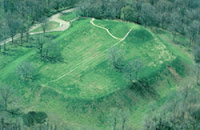Thirteen Things About The Mississippi Mound Builders

- For more than half a millenium, the Mississippian people successfully cultivated vast agricultural settlements based on corn, squash and beans. However, the Mississippians were much more than prosperous farmers. They also developed a complex and highly organized culture based on a ritualistic relationship between the people and the land. The most notable Mississippian civil centers were Spiro Mounds in what is now eastern Oklahoma, Moundville in Alabama, Etowah Mounds in northern Georgia, and the largest and most elaborate center at Cahokia Mounds in present-day Collinsville, Illinois.
- Massive earthen mounds of varying size and function dominated the great Mississippian landscape.
- Most Mississippian cities were built around a central plaza. Social events at these plazas were certainly varied but included the popular sport of chungke (or chunkey) where men rolled stone discoidals as part of day long competitions that usually included gambling between the players.
- By Mississippian times, the bow and arrow had been perfected and was in common use.
- The Moundbuilders were highly accomplished potters, flint knappers and stone workers who also designed and created many status ornaments such as shell gorgets, ear ornaments and beads.
- Striking differences between the nobles and commoners showing a highly stratified society can be seen among the excavated burials with their grave goods at Moundville.
- The Jones Archaeological Museum was opened and dedicated on May 16, 1939 at what was then known as "Mound State Monument" (Now known as Moundville).
- Designated a National Historic Landmark, Emerald is one of the largest mounds in North America. Covering eight acres, Emerald Mound measures 770 by 435 feet at the base and is 35 feet high.
- Emerald Mound, built and used during the Mississippian period between 1250 and 1600 A.D.,was a ceremonial center for the local population, which resided in outlying villages and hamlets. Its builders were ancestors of the Natchez Indians.
- The period of construction of Nanih Waiya Mound is uncertain. Although its rectangular, flat-topped form is typical of Mississippian period mounds (1000 to1600 A.D.), pottery sherds found on the surface of the adjacent habitation area suggest a possible Middle Woodland time range (100 B.C. to 400 A.D.). Until archeological investigations are undertaken, however, the mound's actual age will remain unknown. (We visited Nanih Waiya Mound when we first started homeschooling).
- The term “Mound Builders” arose when the origin of the monuments was considered mysterious, most European Americans assuming that the Native Americans were too uncivilized for this accomplishment. In 1894, Cyrus Thompson of the Smithsonian Institution concluded that the Mound Builders were in fact the Native Americans.
- The earliest mounds in the United States have been found at Watson Brake near Monroe, La.; they were built in the late 4th millennium B.C.
- Today, the legacy of the moundbuilders is at risk. Most earthworks, lacking Emerald's visibility, are worn down to unassuming shapes in the overgrowth along remote fields and tributaries. Many have been looted or damaged by farming and construction; of almost 1,100 known sites in Arkansas, only 2 remain relatively untouched. Earthworks at Toltec, Parkin, Chucalissa, and Pinson—all state sites open to the public—testify to the greatness of the Delta's architects.
|



